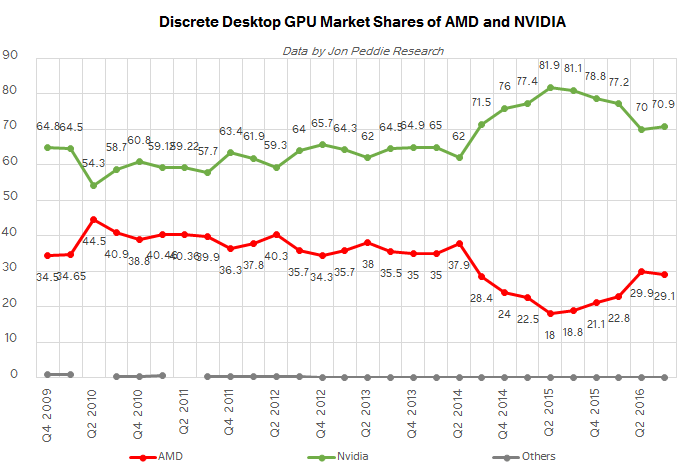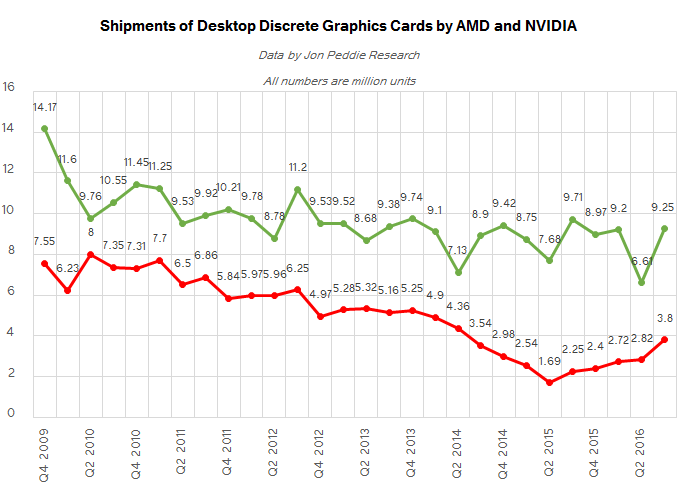Discrete Desktop GPU Market Trends Q3 2016: GPU Shipments Hit Two-Year High
by Anton Shilov on November 28, 2016 9:00 AM ESTMarket Share: AMD Is Increasing Units, Not Share
Last year AMD addressed the high-end of the market with unique products like the Radeon R9 Fury series with HBM memory, as well as the Radeon R9 Nano aimed at small form factor systems. This year the company decided to focus on mainstream video cards with its Radeon RX series (previously known as Polaris). So far, this tactic has been paying off: over the past 12 months, AMD regained over 10% of the market and increased quarterly shipments of desktop discrete GPUs by over 1.5 million units.
AMD shipped approximately 3.8 million standalone graphics chips for desktop computers in the third quarter of 2016, which is a two-year high, according to Jon Peddie Research. The company’s desktop discrete GPU sales were up nearly one million units from the previous quarter (an increase of 34%) and grew by over 1.5 million units from the same period last year (an increase of 68.8%). Meanwhile, AMD’s market share declined 0.8% from the previous quarter (Q2 2016) due to strong NVIDIA performance but surged 10% from Q3 2015.
NVIDIA also managed to increase its discrete desktop GPU shipments in the third quarter significantly. The company sold 9.25 million GPUs, up from 6.61 million in Q2 2016 (an increase of about 40%), and up from 8.97 million in Q3 2015 (an increase of 3.1%). NVIDIA typically clears out its inventory in the second quarter, hence, its sequential growth of chip sales in the third quarter is not particularly surprising. Meanwhile, the company has managed to bring its sales back to recent historical levels, which is not bad on a market that has been on a decline for years.












53 Comments
View All Comments
Atique786 - Friday, October 1, 2021 - link
This is a very informative and interesting article. I have enjoyed reading your post and have come to the conclusion that you are a professional writer.https://realrelaxmassagechairreview.com/
<a href="https://realrelaxmassagechairreview.com/">... Relax Massage Chairs</a>
<a href="https://realrelaxmassagechairreview.com/real-relax... Relax Massage Chair Review</a>
<a href="https://realrelaxmassagechairreview.com/real-relax... Relax 2020 Massage Chair</a>
Atique786 - Friday, October 1, 2021 - link
This is a very informative and interesting article. I have enjoyed reading your post and have come to the conclusion that you are a professional writer.https://realrelaxmassagechairreview.com/
<a href="https://realrelaxmassagechairreview.com/">... Relax Massage Chairs</a>
<a href="https://realrelaxmassagechairreview.com/real-relax... Relax Massage Chair Review</a>
<a href="https://realrelaxmassagechairreview.com/real-relax... Relax 2020 Massage Chair</a>
tipoo - Monday, November 28, 2016 - link
This is an important counterpoint to the "PC shipments are falling" doom and gloom. PC shipments are falling because a 5 year old 2500K can still run modern games if the GPU allows. But PC /gaming components/ are on the upswing, so it's still a great time to be a PC gamer. Complete system sales are tertiary.BrokenCrayons - Monday, November 28, 2016 - link
This sums up the state of the declining computer sales nicely. While CPU performance and platform features (minor nod to USB) haven't pushed the performance envelope enough to matter AND software isn't demanding more, the GPU industry is driven by pent-up demand for a die shrink and widespread increases in screen resolution.Threska - Sunday, December 4, 2016 - link
Well the killer uses for GPUs are going to be VR and machine learning.0ldman79 - Monday, November 28, 2016 - link
That's not necessarily a problem.We need tech to settle a bit. That might actually increase overall ownership and total market penetration. Having to upgrade the machine every two years just to keep up has kept a lot of people out of the market for anything but the cheapo computer.
Strunf - Thursday, December 8, 2016 - link
People didn't upgrade the machines every two years to keep up, CPU wise we have reached a good enough CPU for the average user like 10 years ago, people who upgrade every 2 years are enthusiasts and they will keep to do so, the ones who stopped upgrading are the ones that have a already good enough PC... or the vast majority of PC users and companies.There isn't really a problem, PC shipment will keep going down cause a PC has nowadays a very long useful life and cause of other technologies, tablets already replaced the PC on many households... my guess in a few years Gamers will represent the vast majority of the PC users and until then desktop PC sales will keep going down, and even then there are new technologies that allow to play PC Games over the network without even having a PC.
stephenbrooks - Tuesday, November 29, 2016 - link
Another thing to bear in mind with these graphs is the comparative improvement of integrated graphics over the time frame. It must be eating the low-end of discrete GPUs by this point.Samus - Tuesday, November 29, 2016 - link
The problem isn't just a 5 year old 2500K is adequate for most common games, but many other tasks, especially simple content consumption, are clearly delegated to other devices most prominently smart phones and tablets.Unless you desire a PC for gaming, or you are a business owner that is sticking to the legacy operations schema (and not modernizing your IT infrastructure) then desktop PC's don't offer any clear compelling advantage over laptops and mobile devices.
Meteor2 - Wednesday, November 30, 2016 - link
Well, AIOs look nice, and are nice to use. Whether they're actually 'desktops', as they use laptop components, is another question.